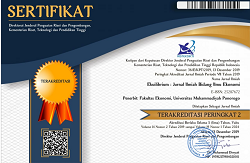Investigating Performance Installation of Hospital Room Surgery of Six Hospitals in Special Region of Yogyakarta by Using Data Envelopment Analysis Model Constant Return to Scale
DOI: 10.24269/ekuilibrium.v13i1.2018.pp1-10
Abstract
This study aims to investigate the efficiency level of hospital surgery hospital installation in Special Region of Yogyakarta Province. Research conceptual constructs are based on input and output performance in institutional performance processes. This research approach uses positivist pattern and is derived by quantitative method. This is to explain the efficiency pattern of the installation of hospital and private hospital surgery rooms. The quantitative method chosen is the concept of Data Envelopment Analysis (DEA). The results showed that 1) the installation of a private hospital surgery room tends to be more efficient than government property; 2) the installation of a special hospital surgical hospital is not absolutely more efficient than a public hospital. As a recommendation, this research provides scenario for setting input usage for efficient performance.
Keywords
Hospital, surgical room installation, efficient.
References
- Coelli, T.J.(1996) “A Giude to DEAP 2.1 Program: A Data Envelopment Analysis Program, Centre for Efficiency and Productivity Analysis (CEPA), Working Paper, USA.
- Halme, Merja & Pekka Korhonen.,(1998) “Restricting Weights in Value Efficiency Analysis”, Interim Report, IR-98-104, IIASA, Laxenburg, Austria.
- Halme, Joro, & Koivu. (1998) “Dealing with Interval Scale Data in Data Envelopment Analysis”, Interim Report, IR-98-112, IIASA, Laxenburg, Austria.
- Kalhor, R., Amini, S., Sokhanvar, M., Lotfi, F., Sharifi, M., & Kakemam, E. (2016). Factors affecting the technical efficiency of general hospitals in Iran: data envelopment analysis. The Journal Of The Egyptian Public Health Association, 91(1), 20-25.
- Kuncoro, H. (2002), “Evaluasi Sektor Dalam Kebijakan Upah Minimum Regional (UMSR) Dengan Metode DEA”, Media Ekonomi Vol 8 No.3, Desember 2002.
- Pribadi, Krishna N..(2004) “Pengukuran Kinerja Wilayah Kabupaten/Kota dalam Industri Manufaktur: Aplikasi Metode Data Envelopment Analysis (DEA) untuk Wilayah Kabupaten/Kota di Jawa Barat tahun 1987, 1992, dan 1997”, Jurnal IPB, Bogor, 2004.
- Pusat Antar Universitas Studi Ekonomi Universitas Gadjah Mada (2000)., “Metodologi Empiris Data Envelopment Analysis”, Modul PAU UGM, Yogyakarta, 2000.
- Samudro, B. R.,(2005) “Analisis Kinerja Industri Manufaktur di Wilayah Propinsi: Aplikasi Data Envelopment Analysis (DEA) Model Constant Return to Scale (CRS) dan Variabel Return To Scale (VRS) di Propinsi Jawa Tengah Tahun 2004, Makalah Seminar Nasional UNPAR, 2005
- Sasono, A., et al., (1994), Pembaruan Sistem Upah, Departemen Tenaga Kerja dan CIDES, Jakarta,.
- Sengupta, Jati K. (2000), “Dynamics and Stochastic Efficiency Analysis”, Economics of Data Envelopment Analysis, World Scientific Publishing Co, Singapore, 2000.
- Thanassoulis, E., De Witte, K., Johnes, J., Johnes, G., Karagiannis, G., & Portela, C. S. (2016). Applications of data envelopment analysis in education. In Data Envelopment Analysis (pp. 367-438). Springer US.
Refbacks
- There are currently no refbacks.

This work is licensed under a Creative Commons Attribution-ShareAlike 4.0 International License.













